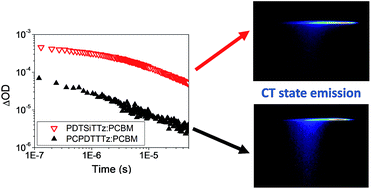The role of emissive charge transfer states in two polymer–fullerene organic photovoltaic blends: tuning charge photogeneration through the use of processing additives†
Abstract
The role of charge transfer (CT) states in organic photovoltaic systems has been debated in the recent literature. In this paper the device performances of two structurally analogous polymers PDTSiTTz (also known as KP115) and PCPDTTTz blended with PCBM are investigated, focusing on the effect the processing additive diiodooctane (DIO) has on morphology, charge photogeneration, and, in particular, the CT state characteristics. While DIO has a considerable beneficial effect for PCPDTTTz:PCBM photovoltaic devices, negligible effects are observed for PDTSiTTz:PCBM devices. An emissive CT state able to be quenched by DIO was observed for PCPDTTTz:PCBM, despite relatively small morphological changes. This is only the second instance of CT state quenching by a processing additive to be reported. Formation of an emissive CT state is therefore a loss pathway for PCPDTTTz:PCBM, which can be alleviated through the use of DIO to increase the proportion of CT states that dissociate into free charges. Conversely, the CT state of PDTSiTTZ:PCBM is weak and short-lived, with the DIO having little effect. The CT state dissociates more efficiently for this higher crystallinity system, leading to less evidence of emissive CT state recombination, and high charge photogeneration yields and device efficiencies.


 Please wait while we load your content...
Please wait while we load your content...